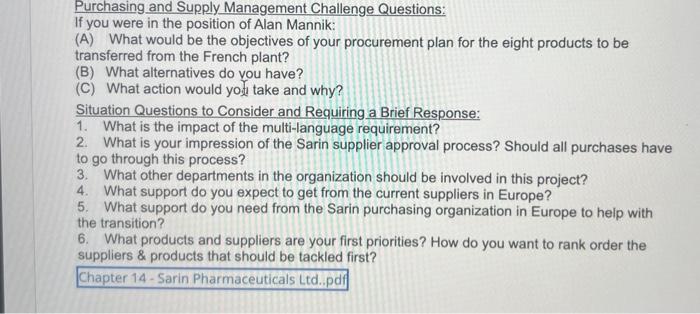Alan Mannik, director of procurement for the Sarin Pharmaceuticals Lid. (Sarin) Animal Health Division plant in Vancouver, British Columbia, was planning for the transfer of eight products from the company's plant in France. He had a conference call with Francois Simpson from the Sarin facility in Arras, France, on June 11 to discuss details of the transfer. It was Monday, June 2, and Alan needed to prepare for the meeting, which was set up to review purchasing transition issues. He was particularly concerned with the supply of raw materials and packaging. SARIN PHARMACEUTICALS LTD. Founded in 1865, Sarin was headquartered in New York and had a reputation for excellence and innovation in the discovery, development, and manufacturing of medicines for people and animals. In the most recent year, company revenues were $12 billion, with net income of $1.4 billion. The company employed more than 45,000 people who worked in 60 countries. Sarin was organized into four segments: pharmaceuticals, vaccines, consumer health, and animal health. The Pharmaceutical Division accounted for approximately 70 percent of company revenues, while the Vaccine, Consumer Health, and Animal Health Divisions represented 13 percent, 10 percent, and 7 percent of Sarin's revenues, respectively, The Pharmaceutical Division developed and manufactured medicines for the treatment of a variety of serious and chronic diseases. such as cancer, epilepsy, and heart disease. The Vaccine Division produced pediatric and adult vaccines to prevent a range of infectious diseases, including hepatitis A and B, polio, and influenza. The Consumer Health Division focused on a wide range of consumer health products in the areas of skin care, wellness, oral care, and nutrition. The smallest division, Animal Health, developed and produced medicines for livestock, poultry, and pets. Sarin focused on its strategic mission of discovering, developing, and bringing to market health care products in an effective manner that fulfilled unmet medical needs. As a result, the company had recently divested a number of operations that did not align with the company's strategy. A number of businesses that complemented Sarin's strategy had recently been acquired, and additional acquisitions were expected to be announced during the coming year. ANIMAL HEALTH DIVISION The Animal Health Division was facing major changes. The company recently purchased Milway-Kitsch Animal Health (MKAH), which would push Sarin to the number one position in the world in animal bealth products. Sarin had traditionally held a leading position in medicines for large animals, plus a strong presence in Latin America and Asia. MKAH, on the other hand, had strong product lines in the pet market in North America and in vaccines wotldwide. They also had superior organizational strength in Europe and Australia. It was pianted that the merger of these two firms would lead to the creation of a single, integrated unit that would place Saris in a position to achieve the vision for the Animal Health Division: "We will be the driving force in the animal bealth industry." The number of manufacturing tacilities for the combined company numbered 46 in 35 different countries. PROCUREMENT The manufacturing process for animal health products required the acquisition of a wide variety of chemical compounds, syringes, boules, packaging materials, and labels. Most of the products manufactured by Sarin were subject to stringent regulatory requirements, such as content, seale for the unit of measurement, language, and dosage, which varied by country. The procurement organization at the Vancouver plant was responsible for sourcing mote than 1,600 raw material and packaging items with a total annual value of $22 million (Canadian). Each item had to be purchased from an approved Sarin supplier. The approval process involved a series of tests and reviews that could take a year to complete and involved the following steps: 1. A copy of the standard operating procedures for the product had to be provided and approved by Sarin. 2. A certificate of analysis of a sample lot had to be provided, manufactured according to the process established in the standard operating procedure. 3. Three random samples from different lots were required for testing, along with a certificate of anal. ysis. These samples were tested by Sarin and the results compared to the certificate of analysis. 4. The supplier processes and capabilities needed to meet acceptable standards in the areas of product development, quality control, and manufacturing. 5. A pilot batch would be run at Sarin, using materials from the supplier, and tested. 6. Only after the supplier had successfully passed steps 1-5 could the product be used in production. The first three lots shipped by the supplier were to be tested by Sarin. Only if all three lots were approved would the supplier be approved. Future shipments would be subject to periodic testing. CLOSURE OF THE FRENCH PLANT It was announced in March that Sarin's only Animal Health plant in France would be closing by May of the following year. The eight products manufactured there would be transferred to the Vancouver plant on a phased basis starting in December and commencing full production a year later. It was planned that the French plant would increase production sufficiently to provide inventory to satisfy demand until the Vancouver plant could provide adequate supply. The addition of the eight products to the Vancouver portfolio would increase production by 30 percent (see Exhibit 1). Capacify was not an issue. By late May, it had become apparent that the French plant would not be able to increase production for sufficient inventory to last for the phase-in period due to low-productivity rates and morale issues. Also, French regulations restricted the ability of the plant to run overtime. It was elear that the transition to the Vancouver plant would have to be achieved earlier than planned to avoid product shortages. EXHIBIT 1 Products to Be Transferred from France to Vancouver Chapter 14 Global Supply Management 449 The approximately 300 approved suppliers for the French plant consisted of both large and small operations that were located all over Europe. A sample of some of the suppliers were as follows: Company name: E. Durand Location: Metz, France Size: Approximately 400 employees Product: Chemicals Company name: P.J. Laurent Location: Metz, France Size: Family firm, 3 employees Product: Printing barrel syringes Company name: Union Plastics Location: St. Didier-En-Valley, France Size: Approximately 100 employees Product: Syringe barrels and plungers for syringes Company name: Loffler AG Location: Freyung, Germany Size: Approximately 500 employees Product: Chemicals As Alan contemplated his moves over the next six months, he wondered how he could ensure that the Vancouver plant had all the necessary supplies for production in an efficient and timely manner. Purchasing and Supply Management Challenge Questions: If you were in the position of Alan Mannik: (A) What would be the objectives of your procurement plan for the eight products to be transferred from the French plant? (B) What alternatives do you have? (C) What action would yoli take and why? Situation Questions to Consider and Requiring a Brief Response: 1. What is the impact of the multi-language requirement? 2. What is your impression of the Sarin supplier approval process? Should all purchases have to go through this process? 3. What other departments in the organization should be involved in this project? 4. What support do you expect to get from the current suppliers in Europe? 5. What support do you need from the Sarin purchasing organization in Europe to help with the transition? 6. What products and suppliers are your first priorities? How do you want to rank order the suppliers \& products that should be tackled first










